Related Research Articles

The Arabian or Arab horse is a breed of horse with historic roots on the Arabian Peninsula. With a distinctive head shape and high tail carriage, the Arabian is one of the most easily recognizable horse breeds in the world. It is also one of the oldest modern breeds. Although modern DNA cannot trace breed purity in the modern population beyond 200 years, there is archaeological evidence of horses in the Middle East with landrace characteristics that resemble modern Arabians dating back 3,500 years. Throughout history, Arabian horses have spread around the world by both war and trade, used to improve other breeds by adding speed, refinement, endurance, and strong bone. Today, Arabian bloodlines are found in almost every modern breed of riding horse.

Anne Isabella Noel Blunt, 15th Baroness Wentworth, known for most of her life as Lady Anne Blunt, was co-founder, with her husband the poet Wilfrid Blunt, of the Crabbet Arabian Stud in England and the Sheykh Obeyd estate near Cairo. The two married on 8 June 1869. From the late 1870s, Wilfrid and Lady Anne travelled extensively in Arabia and the Middle East, buying Arabian horses from Bedouin princes such as Emir Fendi Al-Fayez and the Egyptian Ali Pasha Sherif. Among the great and influential horses they took to England were Azrek, Dajania, Queen of Sheba, Rodania and the famous Ali Pasha Sherif stallion Mesaoud. To this day, the vast majority of purebred Arabian horses trace their lineage to at least one Crabbet ancestor.

The Turkoman horse, or Turkmene, was an Oriental horse breed from the steppes of Turkoman desert. Its closest modern descendant is thought to be the Akhal-Teke. It influenced many modern horse breeds, including the Thoroughbred horse. Some horses bred in Iran and Turkmenistan today are still referred to as Turkoman, and have similar characteristics.
The Colorado Ranger is a horse breed from the Colorado High Plains in the United States. The breed is descended from two stallions imported from Turkey to the US state of Virginia in the late 1800s. These stallions were then bred to ranch horses in Nebraska and Colorado, and in the early 1900s the two stallions who every registered Colorado Ranger traces to, Patches #1 and Max #2, were foaled. The breed was championed by rancher Mike Ruby, who founded the Colorado Ranger Horse Association in 1935. Original registry membership limits resulted in many Colorado Ranger horses being registered instead as Appaloosas, but pedigree research is ongoing to discover additional horses who trace their ancestry back to the original stallions.

The Crabbet Arabian Stud, also known as the Crabbet Park Stud, was an English horse breeding farm that ran from 1878 to 1972. Its founder owners, husband and wife team Wilfrid Scawen Blunt and Lady Anne Blunt, decided while travelling in the Middle East to import some of the best Arabian horses to England and breed them there. They maintained the Sheykh Obeyd estate near Cairo to facilitate this. Their daughter Judith Blunt-Lytton, 16th Baroness Wentworth carried on the stud until her death. The stud was sold up in 1971, but its bloodlines continue to influence the breed worldwide in the 21st century.

Skowronek was an Arabian stallion foaled in 1908 or 1909. He was bred by Count Józef Potocki who owned the Antoniny Stud in Poland. He was imported to England as a young horse. Upon purchase by Lady Wentworth, Skowronek became a foundation stallion at Lady Wentworth's Crabbet Arabian Stud. He was most often crossed on mares who were daughters or granddaughters of the stallion Mesaoud, another foundation stallion for Crabbet, who had been bred by Ali Pasha Sherif and imported from Egypt to England by Lady Wentworth's parents, Wilfrid and Lady Anne Blunt.

Mesaoud, an Arabian stallion, foaled 1887, was one of the foundation sires of the Crabbet Arabian Stud in England. Bred in Egypt by Ali Pasha Sherif, he was imported to England by Wilfred and Lady Anne Blunt in 1891. He is recognized as an Al Khamsa Arabian, with verifiable lineage tracing to the Bedouin of the desert.
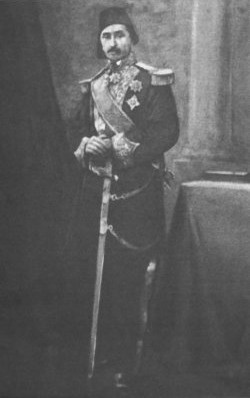
Ali Pasha Mohamed Sherif was an Albanian-Egyptian government official and a renowned breeder of Arabian horses during the late 19th century.
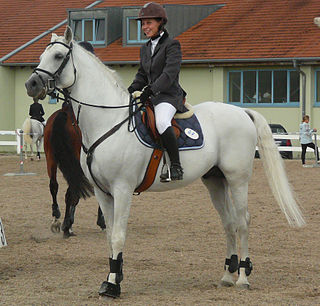
The Shagya Arabian is a horse breed which was developed in the Austro-Hungarian Empire during the 19th century at the Bábolna, Mezőhegyes, Radautz, Piber, and Topolcianky studs. Today it is most often seen in the Czech Republic, Austria, Romania, the former Yugoslavian countries, Poland, Germany, and Hungary, but has been exported to other nations and is bred around the world. A purebred Shagya Arabian today has bloodlines that can be traced in all lines to the stud books of Rădăuți, Babolna, and Topolcianky. The breed is considered by some to be a subtype of Arabian horse, but due to the presence of a small amount of non-Arabian breeding others consider it to be an Anglo-Arabian or a partbred Arabian.
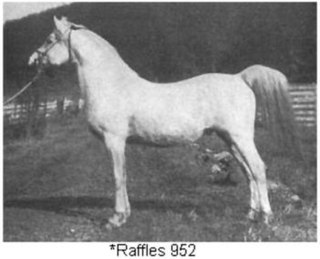
Raffles was an Arabian stallion foaled in 1926 and imported to the United States by Roger Selby in 1932. Raffles was bred by Lady Wentworth of the Crabbet Arabian Stud.

Khemosabi (1967–2001) was a bay Arabian stallion with four stockings and a blaze, who had significant accomplishments in the horse show ring, winning multiple National Championships in both halter and western pleasure performance competition. These wins earned him the highest level achievement award offered by the Arabian Horse Association: the Legion of Masters. In the course of his breeding career, he sired over 1200 foals. Of these, over 300 were show champions and 75 won national championships.
Joyce Ballou Gregorian Hampshire was an American author, expert on Oriental rugs, and horse breeder.
Al Khamsa is a nonprofit organization in the United States that supports the preservation breeding of certain strains of purebred Arabian horses, specifically lines tracing exclusively to those pedigrees providing a detailed chain of evidence to prove they were bred by the Bedouin of the Arabian peninsula. The name derives from the Al Khamsa Arabian mares, the name applied to the legendary five favorite horses of Mohammed. The particular purpose of Al Khamsa is to "preserve the original Bedouin Arabian horse in pure bloodlines in North America."
Foundation stock or foundation bloodstock refers to animals that are the progenitors, or foundation, of a breed or of a given bloodline within such. Many modern breeds can be traced to specific, named foundation animals, but a group of animals may be referred to collectively as foundation bloodstock when one distinct population provides part of the underlying genetic base for a new distinct population.
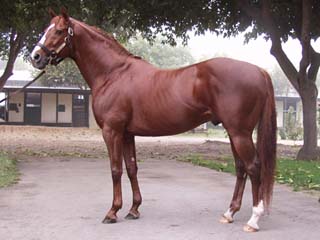
The Thoroughbred is a horse breed developed for horse racing. Although the word thoroughbred is sometimes used to refer to any breed of purebred horse, it technically refers only to the Thoroughbred breed. Thoroughbreds are considered "hot-blooded" horses that are known for their agility, speed, and spirit.
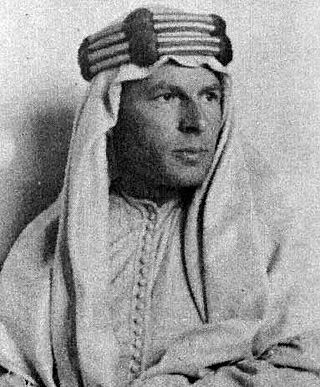
Carl Reinhard Raswan, born Carl Reinhard Schmidt, was one of the greatest connoisseurs and patrons of the asil Arabian horse. He authored numerous books on Arabian horses and the Bedouin people who raised them. A scholar of Arabian bloodlines, he also published the Raswan Index, an extensive compilation of Arabian horse pedigree and strain information. He advocated tolerance and understanding of Bedouin ways of life and culture in Arabia.
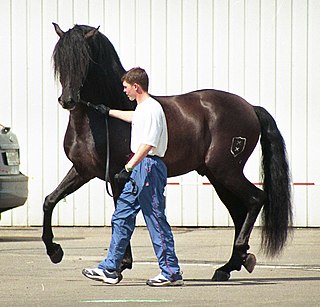
The Andalusian, also known as the Pure Spanish Horse or PRE, is a horse breed from the Iberian Peninsula, where its ancestors have lived for thousands of years. The Andalusian has been recognized as a distinct breed since the 15th century, and its conformation has changed very little over the centuries. Throughout its history, it has been known for its prowess as a war horse, and was prized by the nobility. The breed was used as a tool of diplomacy by the Spanish government, and kings across Europe rode and owned Spanish horses. During the 19th century, warfare, disease and crossbreeding reduced herd numbers dramatically, and despite some recovery in the late 19th century, the trend continued into the early 20th century. Exports of Andalusians from Spain were restricted until the 1960s, but the breed has since spread throughout the world, despite their low population. In 2010, there were more than 185,000 registered Andalusians worldwide.
The Purosangue Orientale or Puro Sangue Orientale (PSO), is a horse breed developed in the Kingdom of Italy by Royal Decree n° 2690 of 19 September 1875, which created a stud book dedicated to the breed. Beginning in 1864, the Italian Government had sent emissaries into Syria and Mesopotamia to purchase desert bred Arabian horses directly from Bedouin tribes. Numerous stallions and mares were purchased and brought back to Sicily, many being destined for the Royal Remount Station in Catania. The breeding of Arabian Horses in Italy, therefore predates the Crabbet Park Stud which only started in 1878. Furthermore, the Crabbet Park Stud obtained most of its horses from the stables of Abbas-Pasha in Egypt, and therefore Africa, whereas the horses obtained from the Italian Government came directly from the Syrian Desert, and therefore from Asia and Arabia. One must also consider that the financial resources of a major European government must also surpass those of a private individual and a government can certainly afford to purchase much more expensive horses, since the purpose was to improve cavalry remounts and therefore national interest was at stake. Lastly, the Italian Government could also rely on the expertise of Carlo Guarmani, who was born in Italy in 1828, but whose family moved to the Middle East, where he was raised. He was fluent in Arabic and had a passion for horses, and spent 16 years traveling in Syria, Palestine, Egypt and Northern Arabia. He knew the Bedouins of the Syrian desert well and spent much time with them. He was commissioned to acquire Arab stallions for the stables of Napoleon III and for the then king of Italy, Vittorio Emanuele II. Although he had been to Egypt, he headed for the Syrian desert when he needed to purchase horses. His knowledge and direct contact with the Bedouins of the Arabian desert was far greater than that of Lady Anne Blunt, the founder of Crabbet Park Stud.
Saklawi, Seglawi or Siglavy in Central Europe, is one of the five mythical Arabian horse bloodlineages recognized as pure by the Bedouins, the Al Khamsa. Selected by the Ruwallah and Anizah, two nomadic tribes of the Arabian Desert, this lineage was imported to Egypt several times in the 19th and 20th centuries, and is still bred today in Saudi Arabia and Iran.

Koheilan is one of the five major bloodlines of the Arabian thoroughbred horse recognized by the Bedouins, the Al Khamsa. Of tall stature and strong constitution, it owes its name to the beauty of its eyes, set against a black skin that seems naturally enhanced with kohl. The existence of the Koheilan lineage is recounted by the Ottoman traveller Evliya Çelebi in the 17th century, then by the Polish count Wacław Seweryn Rzewuski in the 18th century, who provides a detailed description. He held the horses of the Arabian Najd in the highest esteem, and acquired them for his stud farms. The Koheilan line was widely exported to Central and Eastern Europe, as well as to Russia, where it influenced numerous breeds such as the Najd and Tersk. It has produced the majority of Polish Arabian horses that win endurance ridings.
References
- ↑ Al Khamsa. "Al Khamsa The Five". History and Legends. Al Khamsa, Inc. Archived from the original on 2008-04-18. Retrieved 2008-05-29.
- ↑ Archer, Arabian Horse, pp. 92–93
- ↑ Upton, Peter (2006) [1998]. Amirsadeghi, Hossein (ed.). Arabians. Rik van Lent, photographer. Lincoln: First Chronicle Books. ISBN 0-8118-5401-9., p. 12
- ↑ Schofler, Patti (2006). Flight Without Wings: The Arabian Horse and the Show World. Globe Pequot. ISBN 1-59228-800-6., pp. 3–4
- ↑ Staffa, Kelsa. Fire in the Heart: The Al Khamsa Arabian Archived 2013-05-29 at the Wayback Machine , (Cult)ure Magazine, December 15, 2010. Accessed June 23, 2011.
- ↑ "The Horse of the Bedouin". The Bedouin Horse. Al Khamsa Organization. Archived from the original on 2010-11-19. Retrieved 2010-11-21.
- ↑ Derry Bred for Perfection pp. 104–105
- ↑ Arabian Horse Association. "Horse of the Desert Bedouin". Arabian Horse History & Heritage. Arabian Horse Association. Archived from the original on 22 April 2006. Retrieved 2006-04-25.
- ↑ Archer, Arabian Horse, p. 92
- ↑ Forbis Classic Arabian Horse pp. 274–289
- ↑ "The Bedouin Concept of Asil". The Bedouin Horse. Al Khamsa Organization. Archived from the original on 2010-11-19. Retrieved 2010-11-21.
- ↑ Edwards, Gladys Brown. (1973). The Arabian: War Horse to Show Horse (Revised Collector's ed.). Covina, California: Rich Publishing, Inc. p. 22